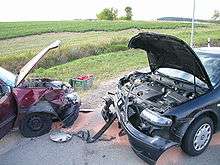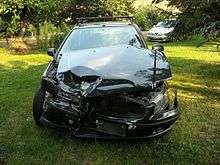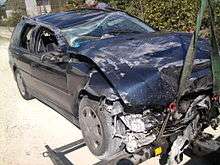Head-on collision


A head-on collision is a traffic collision where the front ends of two vehicles such as cars, trains, ships or planes hit each other in opposite directions, as opposed to a side collision or rear-end collision.
Rail transport
With railways, a head-on collision occurs most often on a single line railway. This usually means that at least one of the trains has passed a signal at danger, or that a signalman has made a major error. Head-on collisions may also occur at junctions, for similar reasons. In the early days of railroading in the United States, such collisions were quite common and gave to the rise of the term "Cornfield Meet." As time progressed and signalling became more standardized, such accidents became less frequent. Even so, the term still sees some usage in the industry. The origins of the term are not well known, but it is attributed to accidents happening in rural America where farming and cornfields were common. The first known usage of the term was in the mid-19th century.
The distance required for a train to stop is usually greater than the distance that can be seen before the next blind curve, which is why signals and safeworking systems are so important.
List of collisions
Note: if the collision occurs at a station or junction, or trains are traveling in the same direction, then the collision is not a pure head-on collision.
-
 September 10, 1874 — Thorpe rail accident, England — telegraph clerk's error; 25 killed
September 10, 1874 — Thorpe rail accident, England — telegraph clerk's error; 25 killed -
 August 7, 1876 — Radstock rail accident, Somerset, England — catalogue of errors through mismanagement; 15 killed
August 7, 1876 — Radstock rail accident, Somerset, England — catalogue of errors through mismanagement; 15 killed -
 September 24, 1904 — New Market train wreck, New Market, Tennessee — engineer error; 56 - 113 killed (exact number unknown)
September 24, 1904 — New Market train wreck, New Market, Tennessee — engineer error; 56 - 113 killed (exact number unknown) -
 July 9, 1918 — Great train wreck of 1918, Nashville, Tennessee — 101 killed.
July 9, 1918 — Great train wreck of 1918, Nashville, Tennessee — 101 killed. -
 January 26, 1921 — Abermule train collision, Montgomeryshire — failure to observe proper procedures; 17 killed.
January 26, 1921 — Abermule train collision, Montgomeryshire — failure to observe proper procedures; 17 killed. -
 October 20, 1957 — Yarımburgaz train disaster, near Istanbul, Turkey: 95 killed.
October 20, 1957 — Yarımburgaz train disaster, near Istanbul, Turkey: 95 killed. -
 November 16, 1960 — Stéblová train disaster, Czechoslovakia: 118 killed.
November 16, 1960 — Stéblová train disaster, Czechoslovakia: 118 killed. -
 1969 — Violet Town railway disaster, Australia — dead driver drives through crossing loop; no ATP; 9 killed.
1969 — Violet Town railway disaster, Australia — dead driver drives through crossing loop; no ATP; 9 killed. -
 May 27, 1971 — Radevormwald, Germany — Dahlerau train disaster A freight train and a passenger train crashed into each other. 46 killed.
May 27, 1971 — Radevormwald, Germany — Dahlerau train disaster A freight train and a passenger train crashed into each other. 46 killed. -
 May 4, 1976 - Schiedam train disaster, The Netherlands: An international train coming from Hook of Holland collided with a commuter train coming from Rotterdam resulting in 24 deaths.
May 4, 1976 - Schiedam train disaster, The Netherlands: An international train coming from Hook of Holland collided with a commuter train coming from Rotterdam resulting in 24 deaths. -
 August 28, 1979 - Nijmegen train disaster, The Netherlands: Two passenger trains—of which one did not contain passengers—collided head-on near the Kolpingbuurt neighbourhood in Nijmegen resulting in 8 deaths.
August 28, 1979 - Nijmegen train disaster, The Netherlands: Two passenger trains—of which one did not contain passengers—collided head-on near the Kolpingbuurt neighbourhood in Nijmegen resulting in 8 deaths. -
 July 25, 1980 — Winsum train disaster, The Netherlands: Two trains collide on a single track between Groningen and Roodeschool resulting in 9 deaths.
July 25, 1980 — Winsum train disaster, The Netherlands: Two trains collide on a single track between Groningen and Roodeschool resulting in 9 deaths. -
 February 8, 1986 — Hinton train collision, Alberta — freight train passed red light due to sleeping crew; 23 killed.
February 8, 1986 — Hinton train collision, Alberta — freight train passed red light due to sleeping crew; 23 killed. -
 October 19, 1987 — Bintaro train crash — two passenger train collided due to signal misunderstanding; 156 killed and more than 300 injured.
October 19, 1987 — Bintaro train crash — two passenger train collided due to signal misunderstanding; 156 killed and more than 300 injured. -
 1989/1991 — Glasgow Bellgrove rail crash and Newton (South Lanarkshire) rail accident, Scotland — both SPAD’s with track layout at single lead junctions a major contributory factor
1989/1991 — Glasgow Bellgrove rail crash and Newton (South Lanarkshire) rail accident, Scotland — both SPAD’s with track layout at single lead junctions a major contributory factor -
 1994 — Cowden rail crash, England.
1994 — Cowden rail crash, England. -
 January 14, 1996 — Hines Hill train collision, Australia — Signal passed at danger at a crossing loop causes a head-on collision
January 14, 1996 — Hines Hill train collision, Australia — Signal passed at danger at a crossing loop causes a head-on collision -
 August 12, 1998 – 1998 Suonenjoki rail collision, Finland – A southbound InterCity train leaves Suonenjoki through a red signal and collides with a northbound freight train.
August 12, 1998 – 1998 Suonenjoki rail collision, Finland – A southbound InterCity train leaves Suonenjoki through a red signal and collides with a northbound freight train. -
 August 2, 1999 — Gauhati rail disaster — Two express trains collide head-on in. Over 285 people are killed.
August 2, 1999 — Gauhati rail disaster — Two express trains collide head-on in. Over 285 people are killed. -
 January 4, 2000 — Åsta accident, Åsta in Åmot, Norway — Two diesel passenger trains collide on the Rørosbanen killing 19. The fire after the collision lasts nearly six hours.
January 4, 2000 — Åsta accident, Åsta in Åmot, Norway — Two diesel passenger trains collide on the Rørosbanen killing 19. The fire after the collision lasts nearly six hours. -
 January 7, 2005 - Crevalcore train crash - head-on collision in Emilia-Romagna, Italy - 17 killed, 80 injured
January 7, 2005 - Crevalcore train crash - head-on collision in Emilia-Romagna, Italy - 17 killed, 80 injured -

 October 11, 2006 — 2006 Zoufftgen rail crash - head-on collision at Zoufftgen, on the border between France and Luxembourg
October 11, 2006 — 2006 Zoufftgen rail crash - head-on collision at Zoufftgen, on the border between France and Luxembourg -
 September 12, 2008 - 2008 Chatsworth train collision- head-on collision in Los Angeles - 25 killed, 135 injured
September 12, 2008 - 2008 Chatsworth train collision- head-on collision in Los Angeles - 25 killed, 135 injured -
.svg.png) February 15, 2010 - Halle train collision - head-on collision between two trains near Brussels, Belgium - 18 killed, 125 injured (estimates)
February 15, 2010 - Halle train collision - head-on collision between two trains near Brussels, Belgium - 18 killed, 125 injured (estimates) -
 January 29, 2011 — Hordorf, Germany — 2011 Saxony-Anhalt train collision - a freight train and a passenger train collided - ten people were killed and 43 people were injured
January 29, 2011 — Hordorf, Germany — 2011 Saxony-Anhalt train collision - a freight train and a passenger train collided - ten people were killed and 43 people were injured -
 April 21, 2012 - 2012 Sloterdijk train collision - head-on collision between two trains in Sloterdijk, Netherlands - 1 killed, 117 injured
April 21, 2012 - 2012 Sloterdijk train collision - head-on collision between two trains in Sloterdijk, Netherlands - 1 killed, 117 injured -
 February 9, 2016 - Bad Aibling rail accident - 11 dead, 85 injured.
February 9, 2016 - Bad Aibling rail accident - 11 dead, 85 injured. -
 July 12, 2016 - Andria-Corato train collision - head-on collision in Apulia, Italy - 27 dead, 50 injured.
July 12, 2016 - Andria-Corato train collision - head-on collision in Apulia, Italy - 27 dead, 50 injured.
Sea transport
With shipping, there are two main factors influencing the chance of a head-on collision. Firstly, even with radar and radio, it is difficult to tell what course the opposing ships are following. Secondly, big ships have so much momentum that it is very hard to change course at the last moment.
Road transport


Head-on collisions are an often fatal type of road traffic collision. U.S. statistics show that in 2005, head-on crashes were only 2.0% of all crashes, yet accounted for 10.1% of U.S. fatal crashes. A common misconception is that this over-representation is because the relative velocity of vehicles traveling in opposite directions is high. While it is true (via Galilean relativity) that a head-on crash between two vehicles traveling at 50 mph is equivalent to a moving vehicle running into a stationary one at 100 mph, it is clear from basic Newtonian Physics that if the stationary vehicle is replaced with a solid wall or other stationary near-immovable object such as a bridge abutment, then the equivalent collision is one in which the moving vehicle is only traveling at 50 mph.,[2] except for the case of a lighter car colliding with a heavier one. The television show MythBusters performed a demonstration of this effect in a 2010 show.[3]
Head-on collisions, sideswipes, and run-off-road crashes all belong to a category of crashes called lane-departure or road-departure crashes. This is because they have similar causes, if different consequences. The driver of a vehicle fails to stay centered in their lane, and either leaves the roadway, or crosses the centerline, possibly resulting in a head-on or sideswipe collision, or, if the vehicle avoids oncoming traffic, a run-off-road crash on the far side of the road.
Preventive measures include traffic signs and road surface markings to help guide drivers through curves, as well as separating opposing lanes of traffic with wide central reservation (or median) and median barriers to prevent crossover incidents. Median barriers are physical barriers between the lanes of traffic, such as concrete barriers or cable barriers. These are actually roadside hazards in their own right, but on high speed roads, the severity of a collision with a median barrier is usually lower than the severity of a head-on crash.
The European Road Assessment Programme's Road Protection Score (RPS) is based on a schedule of detailed road design elements that correspond to each of the four main crash types, including head-on collisions. The Head-on Crash element of the RPS measures how well traffic lanes are separated. Motorways generally have crash protection features in harmony with the high speeds allowed. The Star Rating results show that motorways generally score well with a typical 4-star rating even though their permitted speeds are the highest on the network. But results from Star Rating research in Britain, Germany, the Netherlands and Sweden have shown that there is a pressing need to find better median (central reservation), run-off and junction protection at reasonable cost on single carriageway roads.
Another form of head-on crash is the wrong-way entry crash, where a driver on a surface road turns onto an off-ramp from a motorway or freeway, instead of the on-ramp. They can also happen on divided arterials if a driver turns into the wrong side of the road. Considerable importance is placed on designing ramp terminals and intersections to prevent these incidents. This often takes to form of special signage at freeway off-ramps to discourage drivers from going the wrong way. Section 2B.41 of the Manual on Uniform Traffic Control Devices describes how such signs should be placed on American highways.
Sideswipe collisions
Sideswipe collisions are where the sides of two vehicles traveling in opposite directions touch. They differ from head-on collisions only in that the errant vehicle impacts the side of the other vehicle rather than the front. Severity is usually lower than a head-on collision, since it tends to be a glancing blow rather than a direct impact. However, loss of control of either vehicle can have unpredictable effects and secondary crashes can dramatically increase the expected crash severity.
Sideswipe collisions are frequently caused by a failure to control a vehicle.
See also
References
- ↑ California Department of Transportation (2014). California Manual on Uniform Traffic Control Devices (Section 2B.41). Sacramento: State of California. pp. 162–165. Retrieved 1 November 2015.
- ↑ "PhysicsLab: Head-on Collisions 2". Retrieved 9 May 2012.
- ↑ "MythBusters: Mythssion Control - Head-on Collision Experiment". Retrieved 6 May 2010.
| Look up head-on collision in Wiktionary, the free dictionary. |

